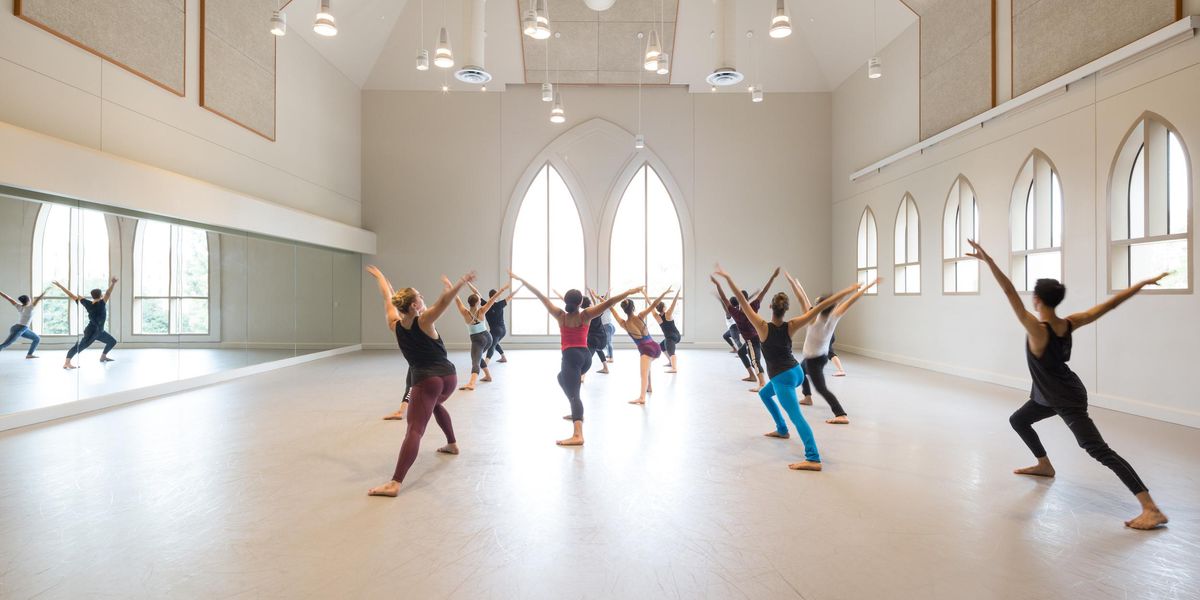DanceVisions, Inc.
“Here & There: A Celebration of Dancers”
Dance Complex
Cambridge, MA
June 8–9, 2012
Performance reviewed: June 8
Margot Parsons, artistic director of DanceVisions, Inc., makes dances based on classical ballet technique but informed by the contemporary practice of borrowing from other movement styles. Although the seven pieces she presented for her troupe’s 30th anniversary concert were basically abstract, gestures such as three women patting the air beside them as if to measure out walls, or the touch of one performer’s hand on another’s shoulder, served to suggest the geography of the space or their relationships. Parsons created all of the works on the 90-minute program, except for a brief but potent solo, Transparent (2012), choreographed and performed by Christine McDowell.
Almost as if reflecting on her own career—from performing professionally in New York and Boston, to spending decades here in Boston as a beloved instructor and choreographer—Parsons made us well aware of the passage of time. The multi-generational casting included one 6-year-old performer, Ruby Giunta, paired with her mother, Daisy, in the charming Dance for Ruby (2012), and two older women moving in different ways but no less succinctly than the eight younger dancers in Tapestry (2012).
Daisy Giunta and 6-year-old Ruby Giunta in Margot Parsons’ Duet for Ruby
Most of the twelve company members (eleven women and one man) have studied with Parsons at Boston University, Boston College, or Harvard. (She currently teaches at all three schools.) The dancers, wearing soft ballet shoes, have been well trained and rehearsed, but like many Boston-based performers, they lack the patina of stage presence. They need more opportunities onstage to acquire the skills of connecting to an audience. For example, in an otherwise fine performance of Temporal Constellation (2012), Nicole DeVicci, perhaps the most technically accomplished member of the company, and her strong and reliable partner, Langston Fishburne, needed to trust their instincts to break free from a strict reading of the choreography and counts. The score, Chick Corea’s Señorita, cried out for a more teasing sense of fun.
Tapestry
, set to Shostakovich, was the most ambitious work of the evening, a shifting mass of quartets, trios, and duets for a cast that ranged in years from teens to late middle-age. At the end, the talented, fully engaged 13-year-old Jacqueline Flynn stood centered between dancers from different generations, predicting good news for the future of the profession.
The fluent dancer Marin Orlosky-Randow delivered a stand-out performance in the solo Flight (2011). Dressed in white, she repeatedly turned in and around one raised arm, before stepping into the space as precisely as a flamenco dancer, her feet echoing the rhythms of William Bolcom’s Summer Dreams. Later, stretches that started deep within her torso propelled her body across the stage.
Julie Krieg and Madelaine O’Connell in Margot Parsons’
Here and There
Dreams
(2011), with an original score by Ai Isshiki and Steven Milton, looked like a nightmare enveloping a trio of dancers, until the climax, when DeVicci and McDowell bonded with the stalwart Fishburne by dangling from his supportive arms, while he carried them forward towards the audience.
Here and There
(2000) featured two women wearing white masks and moving with the tiny curling wrists and petite footwork of Baroque-era dance. In a final image, backs turned, they removed their masks and held them out to us, but never revealed their faces. Parsons has a skill for finding the visual metaphor to end each of her dances with a suggestive phrase, keeping the moment vivid in a viewer’s mind.
Pictured at top:
Christine McDowell, Nicole DeVicci, and Langston Fishburne in Margot Parsons’
Dreams
All photos by Maximal Image®, Courtesy DanceVisions.




